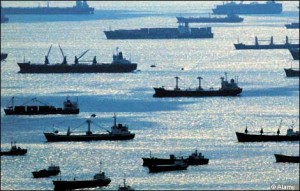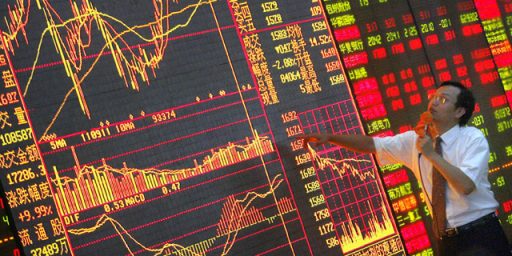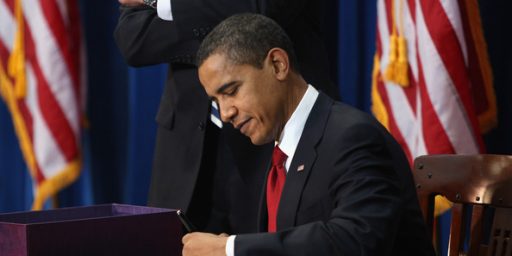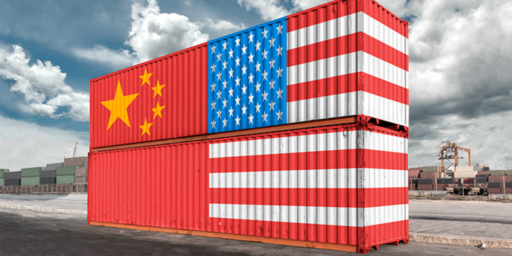The Flip Side of Globalization
 Add Singapore to the list of Asian economies flagging as exports dry up:
Add Singapore to the list of Asian economies flagging as exports dry up:
But as the world enters a period of deglobalization, Singapore is a window into the reversal of the forces that brought unprecedented global mobility to goods, services, investment and labor. With world trade plummeting for the first time since 1982, the long-bustling port has become a maritime parking lot in recent weeks, with rows of idled freighters from Asia, Europe, the United States, South America, Africa and the Middle East stretching for miles along the coast. “We’re running out of space to park them,” said Ron Widdows, chief executive of Singapore-based NOL, one of the world’s largest container lines.
Exports collapsed by 35% in the month of January alone and foreign workers, whether highly paid Europeans or uneducated South Asian peasants, are returning home.
There’s skepticism that China can fill the gap being left by the drop in consumption in Europe and the United States:
“Look, you can’t sell consumer products to the Chinese because they make everything cheaper there already,” Zarchi said. “Unless you have a fruit they cannot grow, a fish they cannot catch or medical equipment they cannot make — yet — then it’s nearly impossible. I don’t see how China can be our future. And yet, I don’t know what else will be either. The Americans? The Europeans? Not for a while.”
Apparently, news of comparative advantage hasn’t made its way to Singapore.
Speaking of China, China has quashed hopes that additional spending by the Chinese government would provide additional stimulus for the world economy:
NEW YORK — Stocks resumed their slide Thursday, as China deflated investors’ hope that the country will boost spending.
Chinese Premier Wen Jiabao said the government’s stimulus plan would help the world’s third-largest economy grow by 8 percent this year, but stopped short of promising new stimulus measures.
The hope that China would unveil more government spending was a major trigger for the stock market’s bounce Wednesday. The rally followed a five-day pummeling that left the market at its lowest levels since 1997.
The premier “had his Timothy Geithner moment,” said independent market analyst Edward Yardeni, referring to the U.S. Treasury Secretary’s speech several weeks ago that the market hoped would reveal details about plans for banks’ toxic assets. “He let everyone down.”
Despite the WTO’s prediction that China’s economy would grow 6.8% this year, below the 8% rate the Chinese authorities have said is necessary to maintain social stability in the country, in the same speech PM Wen announced that, coincidentally, China’s economy would grow at an annual rate of 8%. That’s one of the great things about a totalitarian oligarchy. When you need growth of 8% at 8% the economy will grow. Or so they say.
The picture above is of ships lying idle off the coast of Singapore.





We can look at the numbers, but for what it’s worth, I flew into Singapore 20 years ago and the scene offshore looked to me like the old movies of D-Day invasion. They had a massive parked fleet.
It is after all a major trans-shipment hub, and not so much a source or destination.
There may be a story here, but I can’t help people who propagate these pictures don’t know the normal Singaporean scene.
(Now, I do see a few ships parked off Long Beach, which is unusual, from the 20-year perspective.)
Heh, maybe I’m being a curmudgeon … I know the ports traffics are down around the world … but hate that picture.
The story has the numbers, odograph. They’ve got so many ships parked, they’re running out of space to park them in.
Well, having been there and seen the port, I suspect a skew in these numbers that someone else might not:
The parked freighters at the “long bustling port” looked to me like a D-Day invasion fleet somewhere around 1997. The guy says he is running out of room … ok, but I know what it looked like when he started.
oops, closer to ’87
Here we go, the number of ships layed up worldwide is in the hundreds. Not hundreds in Singapore alone as those hated photos imply:
Subic Bay has a whole 19 ships. I suspect that is more typical of a single location’s surplus.
Just came back from a trip to Hong Kong. Driving to and from between the airport and Central Hong Kong, I didn’t notice any ships idling. Perhaps they were berthed way way out in the ocean out of view of the port, but I only saw a few ships berthed at the docks and then some in the shipyards.
I wonder if there are any consequences for ships flying flags of convenience in this economy. Sepecifically, if they are going to park for a substantial amount of time, do they need to return to Liberia or Panama or the Bahamas?